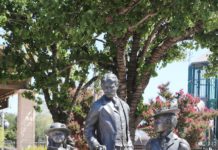What does a school district do when the State of California cuts
more than four million in their budget? They look to other revenue
generating options.
What does a school district do when the State of California cuts more than four million in their budget? They look to other revenue generating options.
That’s exactly what the board members of the Morgan Hill Unified School District discussed in a special meeting Aug. 30: how to generate revenue given the current state of the economy. This special board study session comes on the heels of a $4.5 million deficit in this year’s 2011-12 $70 million budget that the district has balanced.
In a presentation by Isom Advisors, a consultant hired by the district, Jon Isom showed the board three options and statistics: a parcel tax, a general obligation bond and a sales and use tax.
“You’re not alone, many districts have seen this,” said Isom. “If the State of California can’t help, many are saying, ‘Hey, we’re going to help ourselves.’ ”
In data presented by Isom, a parcel tax option could generate between $528,000 to $2 million, depending on the amount per parcel of an estimated 20,311 parcels available to tax within the school district boundaries.
In 2011 elections, 63 percent of district parcel taxes were successful in California. In Santa Clara County, four districts that put up parcel tax measures passed. These include Cupertino Union School District, Los Altos School District, Los Gatos-Saratoga Joint Unified School District and Sunnyvale School District.
Isom said a district needs to also take into consideration when an election will be held, as it will reflect voter turnout. For example, an election at the same time as a presidential primary could attract more voters than a special election.
Putting a parcel tax on the ballot would require a two-thirds majority and also needs to be designated to fund a specific program or use.
In 2006, Morgan Hill voters defeated a $96 parcel tax with just 55.5 percent voting for the measure, shy of the 67 percent voter approval needed. A parcel tax of $99 per parcel would generate upward of $2 million.
A consensus was reached by the board to poll the community and see what their responses would be toward revenue generating options and ballot measures.
A survey could cost as little as $7,000 or as much as $30,000, said Isom. He suggested a fall survey to see what the community thinks, if the district wants the measure on a June ballot.
“That’s becoming a more and more important date for us to know,” said Kathy Sullivan, board vice president.
A general obligation bond could generate about $131.2 million to $174.9 million, depending on the tax rate per $100,000. The district approved a $72.5 million bond in 1999 with the current tax rate at $75.10 per $100,000 in assessed value with a 27-year pay back period that ends in 2026. One option, said Isom, is to extend the already existing tax rate. An extension could add more years to the current bond and could generate the district up to $120.3 million with projected annual assessed growth at 3.5 percent, according to Isom.
“We propose we don’t increase, keep paying what you’re paying and extend it,” he said. “It would be a brand new bond, a brand new measure and a new 55 percent approval requirement.”
The district could generate $120.3 million without increasing the tax rate, with projected annual assessed growth of 3.5 percent, according to Isom’s report.
According to Isom Advisors data, Santa Clara County has had two successful sales tax elections for a .5 percent increase in 1976 and 2006 for the county’s transit district and the Santa Clara County Valley Transportation Authority respectively. The current county sales tax is 8.25 percent, with a maximum cap at 9.25 percent.
If a sales and use tax were approved, the district could generate between an estimated $128,000 to $515,000 annually, said Isom.
An important factor to consider for all revenue generating options is the voter demographics of Morgan Hill, said Isom. About 70 percent of registered voters vote by mail in Morgan Hill. In November 2008 during the presidential election, 82 percent of voters turned up, compared to a low of 27 percent in June 2008. The June 2012 estimated voter turnout is at 60 percent.
Bonnie Tognazzini, Deputy Superintendent, was asked during the meeting where the immediate concern was in terms of where funds are needed.
“My biggest concern with facilities has been the roofs, and Martin Murphy (Middle School)’s lack of,” she said. “We patched and patched. There’s still millions of dollars to be done.”
Several board members expressed concern on being impartial on the various options, and not advocates until the survey results are presented.
“We’re all here with our pre-conceived notions,” said Shelly Thomas, board trustee. “Ultimately, it’s the voters who decide. I think we need to take the first step to let them be a part of the conversation.”
The board agreed to spend the month of September to organize concepts and ideas. According to an outline made by Isom Advisors, a suggested time to conduct a survey would be in January 2012.








